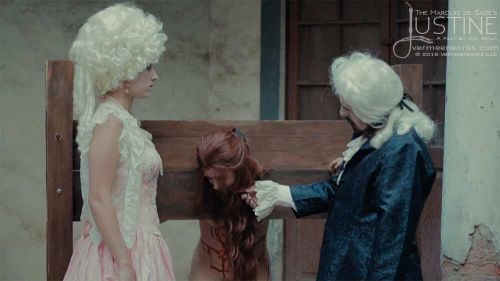by Rich Moreland, September 2020
Once again, I’ve taken the opportunity to review a Jac Avila film. His newest offering is the first in a series starring Dani Borda.
Photos are courtesy of Jac Avila and Red Feline.
* * *
The blurb that accompanies the latest Red Feline offering, CruXtreme I, states in part:
After a drink, a young woman visits her lover’s playroom and comments, “‘It is so medieval, like the Spanish Inquisition.’ ‘Do you want to play?’ He asks. ‘Yes’, she responds. Thus begins a night of extreme torture and terror.”
Lovely and Eager
Jac Avila’s reinvigoration of the Red Feline genre ensures another success with CruXtreme I (CX I). The film follows the time-tested erotic horror formula that built the Red Feline label and its loyal fan base. Central to Red Feline’s cinematic successes are the likes of the talented sisters Carmen and Veronica Paintoux, Mila Joya, Beatriz Rivera, and the dynamic Amy Hesketh, all of whom fans have come to adore for their willingness to suffer.
Now we have Daniela Borda and she is sensational. Dani is lovely, nicely put together from a physical standpoint and overly eager to please. Her personality is bright with abounding smiles. From what this writer sees in her CX I performance, should this dark and alluring girl decide to continue with Red Feline and give Jac more opportunities to explore her likes and limits, she may very well eclipse her predecessors in her performances.
Incidentally, this is not Dani’s first Jac Avila shoot. She broke into the erotic horror genre with a role in Monxa Mala. In that film she is his beloved, a role reprised in CX I. Incidentally, Dani has a history with Red Feline before her role in Monxa, something I discovered when corresponding with Jac.
“Yes, Dani’s first film with me is Monxa Mala,” he says, “but we did a lot of work prior to that film, some of which is good enough to be released as rehearsal movies.”
Hopefully that is in the works soon!
Before we delve into CX I, a helpful comment is appropriate. As a veteran scribe of the adult film industry, I can attest that commercialized pornography revolves around two film variations: the feature and the vignette. With their erotic horror offerings, Jac Avila and Amy Hesketh have created memorable feature films such as the acclaimed Dead But Dreaming and Justine. Productions like these require scripts, substantial budgets, location shooting, and a cast and crew. On the other hand, vignettes are compact and can work without the above. This is the case with CX I.
We’ll talk more about that later. For now, here’s quick run through of the what you will see on-screen.
The Playroom
The opening scene is shot in the bedroom of the male protagonist (Jac Avila). He has a female guest (Dani Borda) and serves her a drink. They’re apparently lovers. At one point, she tells him, “I like to do lots of things,” and inquires as to what he has in mind that might satisfy her. He suggests “Monopoly,” but that is of no interest to her. She says she is “awful” at that game. That settles everything and he lets her in on his ploy: his playroom. She responds hungrily. “I want to see it!”
“Do you like scary?” he asks.
“Yeah, I like it a lot!” she smiles.
And so, the stage is set for Dani’s coming tribulations fueled by the erotic taste of the macabre that thrives at the end of a whip.
The Wheel
The entire film is set around a wheel that is an ominous relic of the Middle Ages. Dani is coy and demure while excitedly open to anything. It’s a delightful combination that sells this movie. She examines the device with carnal fascination . . . or might we suggest loving masochism. When she agrees to be attached to it face down with arms outstretched, her ordeal begins.
With the first blows of the riding crop, Jac asks “Do you like it?”
She answers with a definitive, yet cautious, “yes.”
But as we know in these kinds of Red Feline scenarios, her painful cries will soon overwhelm her enthusiasm, or so we are led to believe. When the intensity builds, she will protest with “It hurts!” and “Okay, stop it!” — words that will invigorate BDSM fans who relish the helpless, punished female. But the certainty of her pleas is somewhat in doubt. Dani is into this.
Over the course of the film, Dani’s naked body is put into four different positions and thoroughly worked over to the viewer’s delight. Her performance reflects touches of Amy’s Red Feline resume. Lots of crying out and then passing out which allows her to be repositioned for the next scene. Best of all, there are no loin cloths to conceal her tender parts, evident when Jac secures her ankles with a homemade spreader bar that reveals all. (Note: Like Jac’s other cinematic victims, Dani is not completely shaved which retains a touch modesty that may disappoint some fans.)
The hallmark of a Red Feline production is the “interlude” when the camera lingers on the tortured motionless body each time the victim succumbs to unconsciousness. The silence during these scenes is deafening. There are long pauses (in literature they are known as frozen moments) while the viewer watches her servile and submissive breathing that assures the anticipation of the next whipping. As if in a painting, the pauses are an artistic rendering of an avenue of female sexuality that has a BDSM niche appeal.
Similar to the quiet moments in Justine when Amy goes under from the whip, splashes of water do the trick and Dani is revived so her tribulation (or should we say “fun”) can continue.
It’s worth a note that when Dani is face up on the wheel, the medieval flavor of the dungeon playroom is reinforced with a spiked belt attachment that secures her waist to increase her pain and eliminate writhing.
Body Art
By the way, Dani Borda is tattooed and pierced. Her body art fits well with the contemporary “outre” female who is perfect for these films. Call it kinky or quirky, no matter. Everything comes together with Dani and her fans—no pun intended, of course.
Speaking of the erotic element, there is frequent kissing during Dani’s trials. It’s a celebration, really, of her beauty and willingness to endure. Never once in the film did this reviewer get the impression that she was not enjoying herself or pleased with her performance. The tone of Dani’s on-screen presence will remind Red Feline aficionados of their past sweethearts (mentioned above) who have endured Jac Avila’s torments.
Before we examine the film’s cinematography in the next post, there is this:
Jac and Dani appear to make love as the final moments of the opening scene transition into their visit to his playroom. Keep that in mind because there is a surprise ending that raises questions about what is really going on in this film: reality or fantasy or flashback? You decide.
* * *
To download Cruxtreme I or order it in a DVD format, head to Vermeerworks.
If you have not yet purchased the tortured female BDSM horror classics Jac mentions here, scroll through the Vermeerworks catalogue for ordering.
And, if you are so inclined, reviews of other Jac and Amy’s feature films appear in the archives of this blog.


































































































